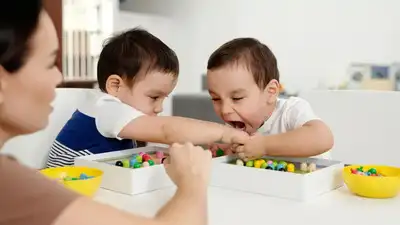ARTICLE AD BOX

Why Does My Toddler Bite, Hit or Push? Understanding Common Aggressive Behaviours (Image: Pexels)
Does your toddler bite, hit, push and grab? While it can be scary or embarrassing for parents, much of this behaviour is normal. The important thing is to understand why it happens, how to respond in the moment, how to prevent repetition and when to seek help.
It is common and often developmentally normal in toddlers
Seeing your toddler bite or hit once in a while is common. Don’t panic at a single incident as it can be a normal stage but pay attention if the behaviour is frequent, escalates or continues past preschool years. According to a 2004 study published in Pediatrics, it is unusual for young children to harm seriously the targets of their physical aggression but studies of physical aggression during infancy indicate that by 17 months of age the large majority of children are physically aggressive toward siblings, peers and adults.
This large developmental work showed that physical aggression (hitting, pushing) rises in infancy/toddlerhood for many children and then declines as language and self-control develop.
There are predictable triggers: Teething, limited language, overstimulation, sensory needs
Biting in daycare settings is especially common among 13–30 month olds. When guessing why your child bit or hit, consider the context: were they tired, hungry, teething, or unable to express frustration? Address the root (offer teething relief, a snack, a calm break or simple words) rather than just punishing. A 2000 research paper, Symptoms Associated With Infant Teething: A Prospective Study, found that increased biting, drooling, gum-rubbing, sucking, irritability and wakefulness were all statistically associated with teething.
Toddlers sometimes bite because they’re teething and seek oral relief. Other common causes (documented in childcare research and practitioner reviews) include not having the words to ask for something, feeling overwhelmed or sensory-seeking.
How adults respond shapes whether the behaviour stops: Stay calm, be firm, teach words
Respond calmly and quickly by ensuring safety, removing the child from the situation briefly, naming the feeling (“You are angry because X”) and teaching an alternative (e.g., “Use your words” or “Hands are gentle”). Avoid long lectures or yelling as these often make things worse.
Coercive cycles, where child misbehaviour is intermittently reinforced and adults escalate, can maintain and increase aggressive behaviour over time. Coercion theory and follow-up reviews show that inconsistent or emotionally charged adult responses can unintentionally reinforce hitting/biting. For example, if a child learns that biting makes adults drop what they are doing and give attention, the behaviour can be maintained.
Strategies that work: Emotion coaching, parent training and structured programs help reduce aggression
Simple emotion-coaching phrases plus consistent limits help. If hitting/biting is frequent or dangerous, ask paediatricians about behavioural parent training programs (many clinics offer PCIT or Tuning in to Kids). Parent–Child Interaction Therapy (PCIT) and other behavioural parent training show improved child regulation and reduced aggression. As per a 2023 study in the Journal of Consulting and Clinical Psychology, PCIT improves inhibitory control and emotion regulation, leading to reductions in child behaviour problems.
Programs that teach parents to label emotions, coach children through feelings and use consistent, predictable consequences (and that build positive parent-child interactions) reliably reduce hitting/biting and improve self-control. Short trainings and coaching sessions can produce measurable changes.
Prevention: Teach skills early, supervise high-risk moments and seek help when problems persist
Use prevention (sleep, snacks, calm transitions), teach alternatives (words, break spaces) and if incidents are frequent or getting worse after a few weeks of consistent response, contact your paediatrician, early intervention services or a child behaviour specialist. Childcare and paediatric guidance reviews (NAEYC, American Academy of Pediatrics) and day-care biting incidence studies show prevention steps and when to escalate. Biting is typical for young children and usually resolves with proper guidance, consistent responses and teaching alternatives. Preventive strategies include:
- High adult-to-child supervision during transitions,
- Teaching and practicing simple words for feelings,
- Role-playing gentle touch,
- Giving toddlers structured choices to increase autonomy and
- Modifying environments that trigger sensory overload.
- For settings like daycare, consistent policies and communication with families reduce recurrences.
- If aggressive acts are frequent, intentionally target social-skills teaching and consult professionals.
Hitting and biting in young children are usually developmental and remediable but they are also teachable moments. With calm, consistent responses that keep everyone safe, teaching of alternatives (words, gentle touch) and simple preventive steps (sleep, food, supervision), most children outgrow these behaviours. If aggression is frequent or severe, early parent training and professional support make a measurable difference.



.png)
.png)
.png)
















 1 hour ago
2
1 hour ago
2









 English (US) ·
English (US) ·